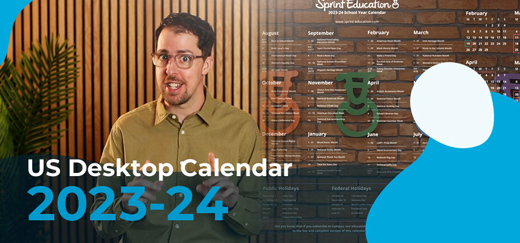Mastering Inbound Marketing to Schools
Mastering Inbound Marketing to Schools
The new edu-marketing cookbook. How do you compare to other sellers to schools?
The new edu-marketing cookbook. How do you compare to other sellers to schools?
The Mission: Fix a broken marketing to schools playbook
Outbound techniques such as emailing, posting, and phoning schools is restrictive. Yes they will continue to reap some rewards for you, but by adopting solely an Outbound marketing strategy you will fail in capturing the attention, and heart of most of the teachers out there who could be, with the right marketing, loyal customers.
The education marketing world has evolved hugely over the past few years, and teachers have become very marketing savvy, they are experts at blocking out your marketing, and instead, they are starting to interactive more with the suppliers to schools that will communicate with them on their own terms.
Some of the best sellers to schools I work with here at Sprint Education are already doing this.
These ‘Grade ‘A’ Marketing Pupils’ have broken free of the marketing to schools stereotypes, they have adopted new marketing techniques, and in doing so have started to build a loyal following of teachers and schools that follow, trust, appreciate, and love them. These companies then see teachers share their marketing content, become advocates of the brand, recommend them to others teachers, purchase from them regularly, and build long-term valuable relationships with not just the brands, but importantly the people working within the brand.
This is Inbound marketing, and to survive the future of selling to schools you will need to update your existing marketing playbook, and support your Outbound content with lovable, engaging, useful, educational, enthralling Inbound marketing.
So how do you achieve this?
Patience old friend! I will explain in good time in this mission statement, but first let’s do study up on the following...
- Delve into the nuts and bolts of today’s schools’ marketing
- Benchmark your marketing performance against others
- Highlight where your marketing is falling short
- Score your overall Inbound marketing performance
Then we will finally...
- Coach you on implementing a new Inbound marketing culture at your company.
Let’s get started!
Inbound vs Outbound
The traditional channels of outbound marketing to schools are:
- Emails to schools
- Emails direct to teachers
- Solo postal marketing
- Shared postal marketing
- Telesales campaigns
Any supplier to schools worth their salt will have utilised some or all of these routes to the education sector in some shape or form over the years, and those that do it well will have yielded incredible returns on investment, whilst others may have floundered.
This traditional marketing playbook is restrictive in today’s fast paced digital education world. Of course you can still generate good results from Outbound marketing, but if you want to build a cornerstone to your company’s future then you must now shake of the shackles of contacting teachers, and begin create an enthralling world surrounding your company and its products /services.
Audit: Benchmark yourself against the sectors
Before we reveal the state of your competitors’ inbound marketing, we need to audit your own marketing to schools to see how you compare. Please answer the following questions.
- Do you currently implement Inbound marketing into your strategy?
- Do you create dedicated landing pages so teachers can complete a lead generation form and provide their information to you?
- Do you offer schools free resources?
- Do you use video in your marketing?
- Do you use AdWords to drive additional traffic to your website?
- How many times a month do you publish new blogs? (Enter ‘0’ if you don’t blog.)
- Do you have a company Facebook and/or Twitter Account?
- How many company Facebook likes do you have?
- How many company Twitter followers do you have?
Sellers to Schools Inbound Marketing Results
1. Do you currently implement Inbound marketing into your strategy?
60% of sellers to schools don’t currently implement Inbound marketing.
Ben’s Conclusion: A large portion of sellers to schools are falling behind the pack. If you are in the 60% who don’t implement Inbound, or know what it is, then thankfully you are reading this mission statement, which might just be the catalyst for you to embrace Inbound, and pull away from the competition.
2. Do you create landing pages so teachers can complete a lead generation form which gives you their buyer persona data?
63% of sellers to schools do not use lead generation forms or collect persona data.
Jackie’s Conclusion: The first step towards the future of your marketing should be built on a solid database of contacts, and importantly their buyer personas. You must understand your target market’s needs so you give them what they want.
3. How often do you send schools free resources?
42% of sellers to schools don’t ever offer schools free resources.
John’s Conclusion: A sure-fire way to win over teachers and to encourage them to follow your company is to give them something very useful for free. A free report, a lesson plan, a trial, whatever it might be, a solid Inbound strategy is built on the quality of what you can give your target market for nothing more than them providing details about their buyer persona. It’s worrying that only 32% are making a real effort to achieve this.
4. How often do you use video in your marketing?
60% of sellers to schools do not currently use any video in their marketing strategies.
Ben’s Conclusion: Video is a tricky one, so a high result of 60% doesn’t surprise me. We implement video into our own strategies here at Sprint so I know it can be costly, time consuming, and difficult to achieve a polished edit. But believe you me, when you nail it, its damn worth all the extra effort. After all, it’s the ultimate way to get your personality across to your market.
5. Do you use AdWords to drive traffic to your website?
59% of sellers to schools do not use AdWords to drive traffic to their websites.
Jackie’s Conclusion: I’m quite dumbfounded by these results! Surely the 59% of sellers to schools are not purely relying on natural listings for web traffic? Well the stats don’t lie, which means this relatively unused marketing channel is a great opportunity to get more leads whilst having full control of spend, position trigger words, and landing pages.
6. How many times a month do you publish new blogs?
On average just 2 new blog posts are published every month by sellers to schools. 44% of companies interviewed don’t ever publish blog posts.
John’s Conclusion: If, like Jackie mentioned, companies don’t use AdWords, then they must rely on natural listings for web traffic. One of the best ways to get ranked higher in Google is to publish regular blog posts with thoughtful, useful, free information that will engage a target market. This will build a loyal Inbound following, and position them as a thought-leader, whilst driving free traffic to their website. 2 blogs a month just doesn’t cut it. At Sprint we publish 4-8 a month and (at the time of writing) it has resulted in our blog site being ranked #1 in Google for the search term ‘Marketing to Schools’. Check it out here: https://sprint-education.co.uk/marketing-to-schools-blog.
7. Which company social media accounts do you have?
37% favour Twitter and 36% Facebook as their company’s main social media accounts.
Ben’s Conclusion: You would expect this owing to how popular the big two social giants are. However, I’m a huge fan of Pinterest, it’s a great way to show a glimpse of your company’s inner- workings and personality which engages visitors and encourages more followers.
8. How many company Facebook likes do you have?
75% of all sellers to schools surveyed have on average a meagre 33 Facebook likes.
Jackie’s Conclusion: This once again highlights how slow some sellers to schools have been in evolving their marketing and company image. Building a solid base of Facebook likes is imperative to expose an ever increasing audience to your company. Why not build ways to boost your likes into your plan, e.g. like us on Facebook to receive a free report about XYZ.‟
9. How many company Twitter followers do you have?
70% of all sellers to schools surveyed have on average just 60 Twitter followers.
John’s Conclusion: I find it difficult to get on with Twitter, because a good tweet is instantly knocked off its perch by a flurry of „white noise tweets‟. That’s not to say it can’t work for you. To really get Twitter working for you, why not use it as a reaction tool for your marketing. Instead of tweeting the usual “For great products call us, blah, blah, blah.” React and respond directly to teachers‟ tweets and conversations which can be related to what you offer. Don’t push for a hard sell, offer support, and then before you know it you have a new inbound lead in your pocket!
Inbound Is Here
Inbound marketing has been an effective marketing method for doing business online for a while now, but for some strange reason it seems to have bypassed the education sector. Until now! Here at Sprint Education we’ve decided enough is enough, and feel it is our duty to start coaching our clients towards a better, more sustainable method of marketing, ultimately giving them a stronger, happier client base for years to come.
Inbound marketing focuses on creating quality content through varies marketing channels that attracts prospective customers toward your company. By aligning the content you publish with your customers’ interests, you encourage inbound traffic that you can nurture through your sales funnel, as the following diagram shows.
Let’s break down your sales funnel into 4 zones. Attract, Convert, Close, Delight. As Visitors enter the first zone they will then be moved through the other zones as they evolve into Leads, Customers, and finally Champions (or advocates/promoters of your brand).
The inbound marketing tools required through each zone are described below. (Note the tools are listed next the action where they are first used, but tools like email for example should be across several zones).
Attract
Encouraging the right traffic to your company is important so they are more likely to become leads, and happy customers. To home-in on your ideal traffic you need to understand your customers’ buyer personas. This means finding out what your customers want, what they like, their challenges, and pain points. The tools most important tools to attract the right users to your site are: Blogs, AdWords, social media, outbound emails.
Convert
A visitor to your site must now be converted into to a lead by gathering their contact information, usually achieved through completing an online form on a landing. To get a visitor to complete your form you need to tempt them with a free incentive. With teachers something like a free lesson plan, or teaching resource linked to your service is an ideal way give them something valuable in exchange for their information. The tools most important tools to convert a visitor to a lead are: Landing pages, forms, free reports/resources.
Close
You now need to ensure your Inbound strategy will move your leads down your sales funnel where they will become to paying customers. How can you most effectively accomplish this feat? Marketing tools can be used at this stage to make sure you’re closing the right leads at the right times.
Delight
The whole ethos of Inbound should be to become remarkable, to encourage customers to love you. This mind-set doesn’t end once they are customers, so the final phase of your strategy should be to continue to engage with them, gradually nurturing them into champions of your brand. The tools most important tools to delight your customers are: personalised content, rewards.
The Next Step...
Inbound marketing doesn’t just happen overnight, you need to remain focused using tools and applications that help you create and deliver content that will appeal to precisely the right people (your buyer personas) in the right places (channels) at just the right times (lifecycle stages).
However, having the time, expertise and technology to launch and maintain an Inbound strategy is no mean feat! That is why Sprint Education have created a new Inbound service focused solely on helping our clients sell more to schools and teachers.
Each strategy we create is unique and tailored to your exact requirements. Simply choose one of our Inbound Blueprints depending on what level of Inbound you want us to implement into your marketing strategies.
What Next?
If you have any questions about inbound marketing to the education sector call us on 01684 297374 or email us at info@sprint-education.co.uk.
Tags
Inbound Marketing
Marketing to Schools
Similar Articles


How to Sell to Multi-Academy Trusts
Understand one of your businesses' ultimate decision-makers, and the key periods within the academic calendar to reach them with your edu-marketing.


Marketing Trips, Tours, and Travel to Schools
Learn 10 game-changing insights especially for trips, tours, and travel providers to enhance your education marketing campaigns when emailing schools.


Expert marketing to K-12 support and solutions
Expert marketing to K-12 solutions
Email Principals, Teachers, and District Staff Inboxes
Email teachers and staff inboxes
Sell More to US and Global Schools and Districts
Sell more to schools and districts
































